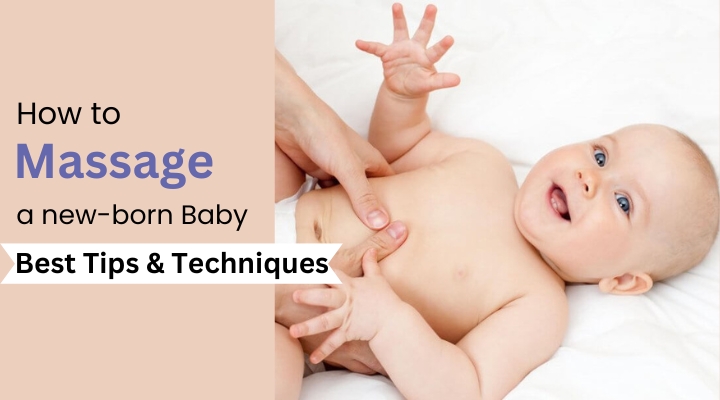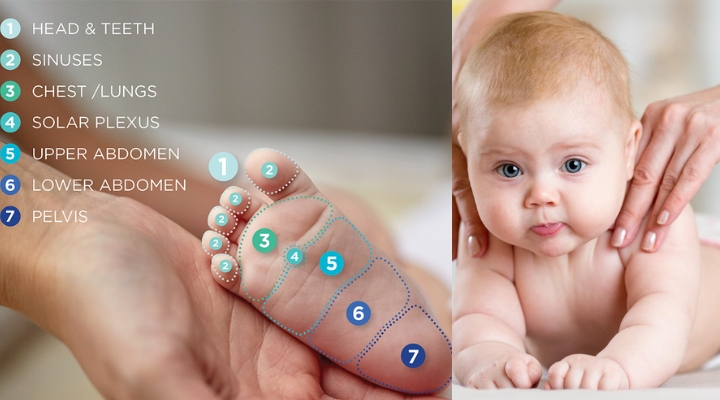How to Massage a NewBorn Baby- Best Tips & Techniques
Welcoming a newborn baby into the world is a joyous and transformative experience for parents. As they begin on this new journey, providing the best care and nourishment for their little ones becomes their top priority. In this article, we will get to know about “How to Massage a New Born Baby- Best Tips & Techniques to perform a soothing and safe massage for your precious bundle of joy. Massaging a newborn not only strengthens the bond between parents and baby but also aids in their physical, emotional, and cognitive development.
Benefits of Newborn Baby Massage
Massaging a newborn baby has been practiced for centuries in various cultures around the world. It offers numerous physical and emotional benefits for the little one. Let’s understand the wide-ranging benefits it offers to both infants and parents-
Related-10 Best Baby Massage Oils – Which Oil Is Best For Newborn
1. Bonding and Attachment-
Baby massage provides an excellent opportunity for parents to connect with their little ones through nurturing touch. This physical closeness fosters a strong emotional bond, promoting feelings of security and trust between the baby and their caregivers.
2. Enhanced Circulation-
Gentle strokes during the massage stimulate blood flow and improve circulation in the baby’s body. Better circulation means more oxygen and nutrients reach the cells, supporting overall growth and development.
3. Improved Sleep-
A relaxing massage can help soothe fussy or colicky babies and improve their sleep patterns. The gentle touch and calming atmosphere induce a sense of relaxation, making it easier for the baby to fall asleep and stay asleep for longer periods.
4. Digestive Comfort-
Baby massage can aid in easing gas and constipation discomfort. Certain massage techniques can gently stimulate the baby’s abdomen, promoting healthy digestion and reducing gas buildup.
5. Muscle Development and Flexibility-
As infants’ muscles are still developing, gentle massages can help strengthen and tone them. Additionally, regular massage can improve their flexibility, allowing them to move more freely as they grow.
6. Relief from Teething Pain-
Teething can be a challenging time for babies, and massaging the gums can offer some relief from teething pain and discomfort.
7. Enhanced Body Awareness-
Through touch, babies become more aware of their bodies and gain a sense of their physical boundaries. This heightened body awareness can have positive effects on their motor skills and coordination as they grow.
Also check for- 10 Natural Tips To Make Baby Skin – Healthy & Glowing
8. Reduced Stress and Anxiety-
Infants, like adults, can experience stress and anxiety. Massaging releases feel-good hormones like oxytocin and serotonin, reducing stress levels in both babies and parents.
Preparing for the Massage
Before you begin the massage, it is essential to create a comfortable and safe environment for both the baby and the parent. Here are some tips for preparing for the massage:
1. Choose the Right Time-
Pick a time when your baby is calm and alert but not overly hungry or too full. A good time might be after a bath or when they wake up from a nap.
2. Find a Warm and Quiet Space-
Ensure that the room is warm enough, as babies are more sensitive to temperature changes. Eliminate any potential distractions or noises that could disrupt the massage experience.
3. Gather the Supplies-
Gather all the necessary supplies before starting the massage. You’ll need a soft blanket or towel to lay the baby on, baby-friendly oil or lotion, and a comfortable place to sit.
4. Wash Your Hands-
Before touching your baby, always wash your hands thoroughly to maintain hygiene.
5. Be Patient and Attentive-
Remember that every baby is unique, and their response to massage may vary. Be patient and attentive to their cues to ensure a positive experience.
Techniques for Massaging a Newborn Baby
When massaging a newborn, it’s crucial to use gentle, light strokes and avoid applying too much pressure. Here are some techniques that you can follow:
Related- How To Give Baby A Sponge Bath?
Start with Stroking-
Begin by stroking your baby’s body gently with your palms. Use long, fluid strokes, starting from the head and moving down toward the feet. Keep the pressure light and even. This helps to relax the baby and prepare them for more focused strokes.
Circular Stomach Massage-
To help ease digestive discomforts like gas and colic, use your fingertips to draw small circles on your baby’s tummy in a clockwise direction. This movement follows the direction of the baby’s colon and can be soothing for their digestion.
I Love You Stroke-
Trace the letter “I” on the baby’s left side of the abdomen and then an inverted “L” and “U” on the right side. This stroke can aid in relieving gas and promoting bowel movement.
Face and Head Massage-
With very light and soft touches, stroke your baby’s forehead, cheeks, and jawline. Use your fingertips to draw tiny circles on your scalp. Be careful around the fontanelles, the soft spots on the baby’s head.
Chest and Shoulder Strokes-
Using both hands, stroke from the center of the chest outward towards the shoulders. Be gentle and avoid applying pressure on the breastbone.
Arm and Hand Massage-
Hold your baby’s arm with one hand and use your thumb and fingers to stroke from the shoulder down to the wrist. Gently rotate their wrist and wiggle their fingers. Repeat on the other arm.
Gentle Leg Massage-
Hold your baby’s leg with one hand and use your other hand to stroke from the thigh down to the foot. Gently squeeze and rotate their little ankles and toes. Repeat on the other leg.
Back Massage-
Place your baby on their tummy and stroke their back gently from the neck down to the buttocks. Use slow and rhythmic motions, and make sure to support their head and neck.
Foot Reflexology-
Foot reflexology involves applying gentle pressure to specific areas on the baby’s feet, which correspond to different organs and systems in the body. While this technique is more advanced, it can be a soothing way to address specific issues or provide general relaxation.
Safety Precautions for Massaging a Newborn Baby
While massaging a newborn can be a beautiful experience, safety is of utmost importance. Here are some safety precautions to keep in mind:
Check for Allergies-
Before using any oil or lotion for the massage, perform a patch test on a small area of the baby’s skin to check for any allergic reactions.
Avoid Sensitive Areas-
Be gentle around sensitive areas like the eyes, ears, nose, and genital area. Avoid applying pressure or using oils on these regions.
Skip the Massage if Your Baby is Unwell-
If your baby has a fever, infection, or any other health issues, it’s best to avoid the massage until they are feeling better.
Pay Attention to the Baby’s Cues-
Always be attentive to your baby’s signals during the massage. If they seem uncomfortable or show signs of distress, stop immediately.
Choose the Right Oil-
Select a baby-friendly oil or lotion for the massage. Avoid using adult skincare products, as they may contain ingredients that could irritate a baby’s delicate skin.
Never Leave Your Baby Unattended-
During the massage, never leave your baby unattended on the changing table or any elevated surface. Accidents can happen quickly, and your constant presence is essential.
Building a Routine for Massaging a Newborn Baby
As with any practice, consistency is key. Establishing a regular massage routine can be beneficial for both you and your baby. Here are some tips for building a massage routine:
1. Pick a Time-
Choose a specific time of day that works best for both you and your baby. Many parents find that incorporating massage into the bedtime routine helps their baby sleep better.
2. Be Attentive-
Pay attention to your baby’s cues and preferences during the massage. Some babies may prefer shorter sessions, while others might enjoy a more extended massage.
3. Engage with Your Baby-
Talk, sing, or make eye contact with your baby during the massage to strengthen the bond and make the experience enjoyable for them.
4. Stay Relaxed-
Remember to relax during the massage. Babies are sensitive to their caregivers’ emotions, and a calm and relaxed demeanor will make the experience more enjoyable for both of you.
Baby massage is a beautiful way to connect with your newborn and provide them with several physical and emotional benefits. The gentle touch, soothing strokes, and the loving presence of their caregivers create a nurturing environment that fosters healthy development and a strong parent-child bond.
As you started the journey of baby massage, remember to be patient and attentive to your baby’s cues. Enjoy the time spent with your little one and cherish these precious moments of connection and love. With the techniques and safety guidelines provided in this article, you can confidently begin your baby massage journey and create a joyful and relaxing experience for both you and your baby. Each baby is unique, so feel free to adapt the massage to suit your baby’s preferences.
Frequently Asked Questions-
When is the best time to start massaging my newborn baby?
It’s safe to start massaging your newborn baby from birth, but it’s essential to wait until their umbilical cord stump falls off and their belly button area heals completely. Typically, this takes about one to two weeks. Once the healing process is complete, you can begin with gentle and short massage sessions.
Which oil or lotion is safe for massaging a newborn baby?
When choosing an oil or lotion for baby massage, opt for natural and baby-safe products. Some excellent options include coconut oil, almond oil, or grapeseed oil. These oils are gentle on the baby’s delicate skin and help retain moisture. It’s essential to test a small amount on your baby’s skin first to ensure they don’t have any adverse reactions or allergies.
How long should a newborn baby massage session last?
Newborn babies have short attention spans, so it’s best to keep the massage sessions relatively short, around 10 to 15 minutes. As your baby grows and becomes more accustomed to the routine, you can gradually extend the duration if they seem to enjoy it.
Are there any areas I should avoid massaging on my newborn baby?
Yes, there are some areas you should avoid massaging on a newborn baby. These include the fontanelles, which are the soft spots on the baby’s head. These areas are delicate and should be handled with care. Additionally, avoid massaging any areas with rashes, cuts, or bruises.
Can baby massage help with colic and digestive issues?
Yes, baby massage can be beneficial for babies suffering from colic and digestive issues. Gentle massage techniques, such as circling and pressing on the baby’s abdomen, can help relieve gas and constipation discomfort. However, if your baby’s symptoms persist or worsen, it’s essential to consult a pediatrician for proper evaluation and advice.










